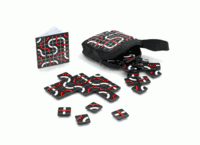Trax (game)
Trax is a two-player abstract strategy game of loops and lines invented by David Smith in 1980.[1]
 Trax tiles | |
| Players | 2 |
|---|---|
| Setup time | 1 minute |
| Playing time | 30 minutes |
| Random chance | None |
| Age range | 8+ |
| Skill(s) required | Strategy |
The game is played with a set of identical square tiles. One side of the tile has red and white straight lines and the other red and white curves.
History
Trax was invented in 1980 and first published in the United States in 1982. Originally, the tiles were made out of cardboard and were red with black and white lines. As the game became more popular, the tiles were changed to high-density plastic. The change to black tiles with red and white lines took place in 2005.
The reigning world champion is Donald Bailey, an engineering professor at Massey University in New Zealand. With the exception of a loss in the 1994 final, he has won every Trax world championship since 1990.
Gameplay
Players place tiles adjacent to those already in play such that the colours of the tracks match. The objective is to get a loop or line of your colour while attempting to stop your opponent from completing a loop in their colour.
If a tile played in any turn forms an adjacent space or spaces into which same coloured track enters from two edges, that same player must play a further tile into each such space so as to join up the same coloured track, be it white or red, as part of that turn. A forced play may itself require further forced plays to be made. A turn is not complete until the only remaining spaces are either single edged spaces or two edged spaces entered by tracks of both colours.
See also
- Tantrix, a connection game played with similar tiles but different gameplay
- Black Path Game
References
External links
Bibliography
- Bailey, Donald (2015). Trax Strategy for Beginners (3 ed.). ISBN 978-0-473-34062-9.